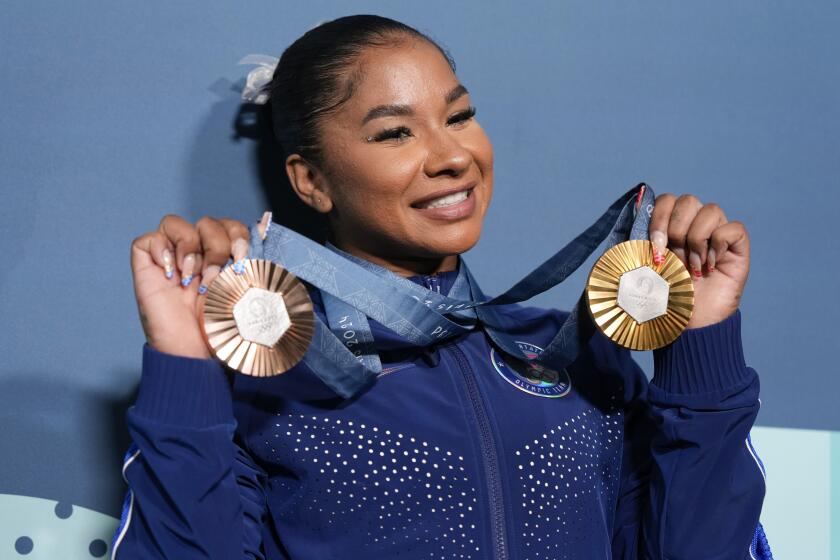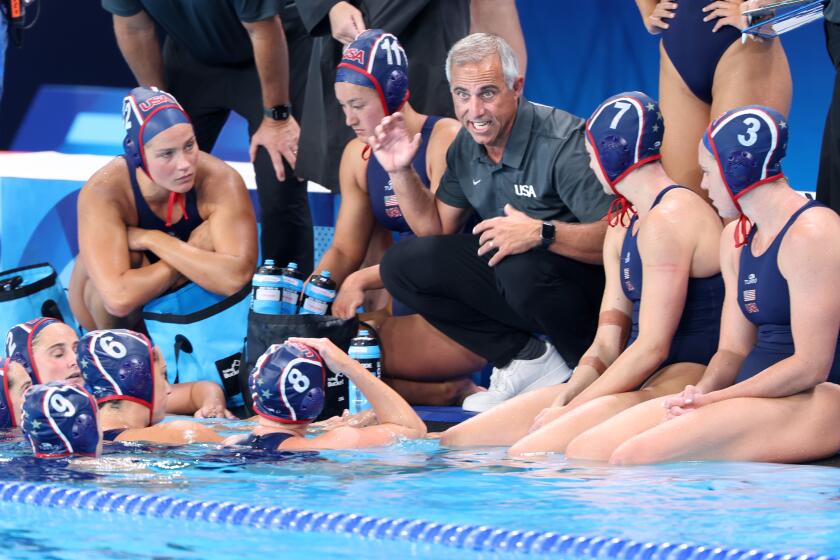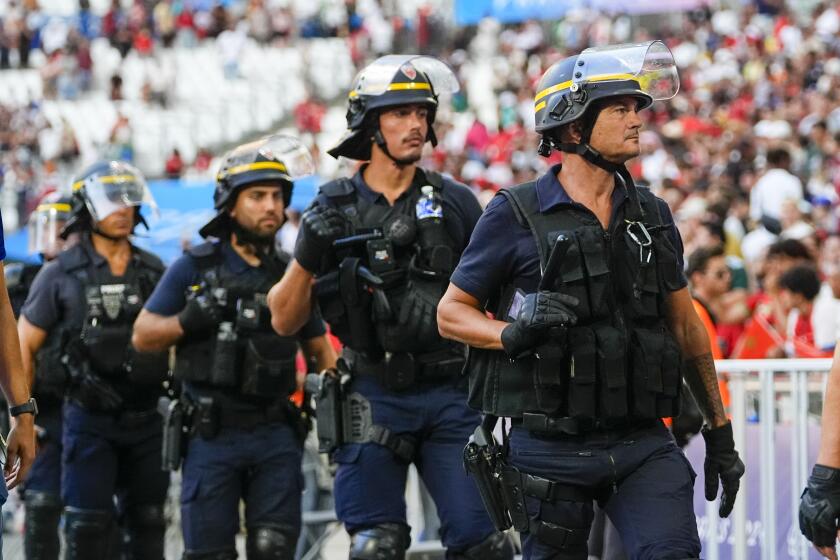O.C. Firm Sees Hot Market for Olympic Emblems
William Wu can attest to the lure of a stylish Olympic lapel pin.
The Irvine businessman recently exchanged a hard-to-find pin for a table in a crowded Atlanta restaurant, and he tells of pin collectors who have traded the decorative souvenirs for meals and airline seat upgrades.
“It’s amazing what you can get for one lousy pin,” said Wu, president of Aminco International Inc., an Irvine-based pin manufacturer.
There will be pins aplenty next month when a growing army of pin collectors marches on Atlanta to wheel and deal. Aminco and a handful of competitors are shipping an estimated 50 million pins--more than were manufactured for the last three Olympic Games combined.
Olympic officials now view pins as another licensing tool that can help generate funds to cover spiraling costs of staging the games, and corporate sponsors consider pins as stylish marketing tools.
But the increasingly commercial nature of what once was a little-known hobby is prompting grumbling among longtime collectors who complain that prices for the rarest and most desirable pins will soar to Olympian heights, while huge production runs dilute the value of other pins.
Counterfeit pins also can wreak havoc on the market, and collectors ruefully acknowledge that there are no guarantees that a given pin will keep its value. Collectors still remember the 1984 Olympic Games, when a pin featuring Sam the Eagle, the Olympic mascot, clutching a soft drink rose to $300 before plummeting in price after several cheap imitations hit the market.
But Wu remains undaunted. He and at least two other pin manufacturers have each paid seven-figure licensing fees for the right to produce pins bearing Olympic symbols. The companies have also struck deals to produce pins for major corporate sponsors that have the rights to use Olympic logos.
Collectors predict that 5,000 or more pin designs will surface before the Olympic flame is extinguished. The 296-page official pin guide includes hundreds of Olympic pins depicting events ranging from archery to yachting. There are scores of national pins that run the alphabetical gamut from Algeria to Uzbekistan. Not to mention thousands of corporate pins--from Coca-Cola, with more than 200 different pin designs, to Xerox, which is offering nearly 90 proprietary designs.
“I’m a bit overwhelmed with it all,” acknowledged Orange retiree Russell Davis, who has amassed more than 3,000 pins since a friend presented him with a colorful pin during the 1984 Los Angeles Games. “You can easily get lost unless you stick to a narrow area of interest.”
Olympic pins first appeared a century ago, when athletes and organizers of the games began wearing them as a form of identification and as symbols of national pride, but interest in pin collecting only started to smolder in the United States at the 1980 Winter Games in Lake Placid, N.Y.
Don Bigsby, founder of Olympin, an 800-member pin collecting group based in Schenectady, N.Y., collected 39 pins from athletes during the 1980 Games. “I was on top of the world,” said Bigsby, whose collection since has grown to include more than 5,000 pins, 18 Olympic torches and a roomful of related Olympic memorabilia.
The pin craze exploded during the 1984 Los Angeles Games when organizers began licensing the Games’ logos to pin manufacturers, and the ranks of collectors began to swell.
Coca-Cola Co. was one of the early corporate sponsors to realize the marketing potential of pins. In the late 1980s, the soft drink company established a subsidiary to sell pins. This summer, more than 500,000 collectors are expected to flow through two Coca-Cola trading centers near the Olympic village.
Pins used to be relatively simple. Most featured the host city’s name, the date and an Olympic logo. But Aminco and a handful of competitors have turned pins into a minor art form, collectors say. The Irvine company has an eight-person art department that uses computers to craft new designs.
“It’s no longer enough to just have a pin,” Wu said. “We now have to have pins on pins, puzzle pins, pins with moving parts.”
Pins now feature clocks and thermometers. One new design includes a slot that spectators can use to hold their sunglasses. Manufacturers are also rushing to introduce popular but expensive puzzle pins, which incorporate as many as a dozen separate pins to spell out a phrase or create a picture.
The new designs seem to be a hit, at least among some collectors. One well-heeled shopper recently offered $6,500 for a massive pin display designed for an Atlanta department store display window. Some fanatics are offering $300 or more for hard-to-find pins--such as a committee pin that the Atlanta Games committee issued in the early 1990s.
Aminco and other manufacturers hope to cash in further with glitzy boxed editions of pins that retail for as much as $1,000.
While collectors pay attention to design details, it’s the limited-edition pins that they truly crave. “We want the pins that are hardest to get,” Davis said. “For a true collector, the joy is in the hunt.”
That’s why media pins worn by television and print reporters--which aren’t generally sold over the counter like many corporate pins--are hot commodities. So are law enforcement pins like those designed by the FBI and the Secret Service. Collectors also clamor for pins that corporate and Olympic Games executives hand out to their friends and associates.
Davis, for example, is especially proud of an FBI pin that’s one of only 550 copies produced: “There just aren’t many of them to go around, which is what makes them so valuable.”
Because of the relatively simple nature of producing pins--most are made of stamped metal parts emblazoned with designs--thousands of unauthorized and counterfeit pins are surfacing for the Atlanta Games. Some are relatively true to the originals; others--like the bogus Coca-Cola design that’s emblazoned with an “Atlanta 98” dateline--border on the comical.
Manufacturers also report that swap meets around the country have been hit with a wave of bright and shiny pins illegally decorated with the Olympic ring and torch designs. Manufacturers and Olympic Games officials say they’re working with police to crack down on bogus pin manufacturing.
Pins now account for almost all of privately held Aminco’s revenue, which will approach $20 million this year. That’s in stark contrast to the early 1980s, when Wu imported belt buckles and other goods for sale in the U.S. In fact, Wu didn’t bid on a pin license for the 1984 Olympics, opting instead to make an unsuccessful bid for a license for Olympic belt buckles.
In retrospect, he says, it was a stroke of luck. “Belt buckles were a disaster because there wasn’t much demand,” Wu said. “But pins just took off.”
Wu has produced hundreds of thousands of pins for World Cup soccer sponsors, and holds contracts to produce pins for professional baseball, football and hockey franchises.
Aminco contracts with domestic producers who manufacture some pins. But the overwhelming majority are air-freighted from a factory in China where 800 workers tackle the gritty, labor-intensive job of stamping and painting the pins.
And Wu already is traveling around the world to negotiate pin rights to upcoming games in Utah, Japan and Australia.
Critics dismiss pins as a fad that, like milk caps, will soon fade from the collectible scene. But Wu and a handful of competitors are betting that pins, driven by sports and corporate sales, will one day be as popular as sports trading cards.
“Pins are now a $250-million retail business,” said Brad Shuman, founder of a San Diego-based company that hopes to ship more than 20 million Olympic pins. “In two years it will be a $500-million business and in a decade it will hit $1 billion.”
But Bigsby, who will be in Atlanta to trade pins for his growing collection, questions whether the rules that govern baseball trading cards apply to pins.
“People go to baseball card shows almost like investors,” Bigsby said. “They rush in looking for the rookie who’s going to be the next Ken Griffey Jr. and then gobble all those cards up because they know they’re going to be worth something.
“Pin collecting is a hobby, not an investment,” he insisted. “I know people who are losing their shirts speculating on pins.”
In Orange, Russell Davis will soon be filling an attache case with “traders” and catching an airplane to Atlanta where he’ll spend his free time looking for like-minded collectors.
“It could be on a street corner or in front of a store,” said Davis, a retired Treasury Department agent who will serve as a volunteer security official for the Games. “It could wind up being anywhere. But what you’ll find is a small army of collectors . . . and you won’t believe the frenzy that can be generated.”
(BEGIN TEXT OF INFOBOX / INFOGRAPHIC)
Aminco International at a Glance
* Headquarters: Irvine
* Founded: 1978
* Business: Designs and manufactures emblematic jewelry such as Olympic pins, key chains, belt buckles, money clips, magnets and license plate frames
* Licensed merchandise: Atlanta 1996 Olympics; Sydney, Australia, 2000 Olympics; National Football League; National Hockey League; Major League Baseball; Major League Soccer and more than 100 U.S. colleges
* President: William Wu
* Employees: 80
* For Atlanta Olympics: 1,000 designs and more than 10 million pins
Source: Aminco International
(BEGIN TEXT OF INFOBOX / INFOGRAPHIC)
Pin Primer
Pins are the second-biggest license for the 1996 Olympics and expected to bring retail sales of up to $500 million. How pins and pin collecting became part of the Olympic Games:
1896, Athens: At first modern Olympics, spectators collect and trade commemorative postage stamps, cards and visitor medals depicting Olympic Stadium.
1912, Stockholm: Pins depicting official poster are sold to spectators.
1924, Paris: Athletes bridge language barriers by exchanging team pins as a gesture of international goodwill.
1960, Squaw Valley (Calif.): Sylvania Electric issues first Olympic sponsor pin at Winter Games; limited quantity makes it popular with collectors.
1980, Lake Placid (New York): Olympin, first Olympic pin club, is formed following Winter Games.
1984, Los Angeles: Interest in pin trading reaches new heights with media and team pins the most sought-after; first pin guide published.
1988, Calgary (Canada): Coca-Cola sponsors its first Olympic Pin Trading Center; Jamaican bobsled team pin becomes prized possession.
Price Guides
* Common pins: Most traders exchange these one for another; some are willing to pay extra ($5-$8) for a pin they really want and have been unable to find.
* Collectible pins: Prices for limited-issue pins have ranged from $9 to more than $10,000. An athlete’s team pin from the 1906 Athens Olympics recently brought $11,000. Prices tend to rise shortly before and after the Games.
For More Information
1996 Olympic Games Pin Society, P.O. Box 182264, Chattanooga, TN 37422
Sources: Official Pin Guide of the 1996 Olympic Games, Aminco International Inc.; Researched by JANICE L. JONES / Los Angeles Times
More to Read
Go beyond the scoreboard
Get the latest on L.A.'s teams in the daily Sports Report newsletter.
You may occasionally receive promotional content from the Los Angeles Times.




